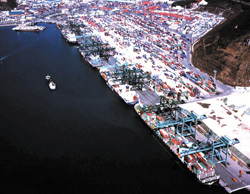BPA Striving to Become Global Port Player
- Adopts innovative management tools to keep it competitive
 The Busan Port Authority (BPA), Korea's first port authority established earlier this year, is now exerting itself to become a global player with a competitive edge with a vision of developing Busan Port as a Northeast Asia hub port.
The Busan Port Authority (BPA), Korea's first port authority established earlier this year, is now exerting itself to become a global player with a competitive edge with a vision of developing Busan Port as a Northeast Asia hub port.
BPA is pushing for enhancing productivity, marketing activities and offering improved services by introducing corporate management strategies.
The following are the excerpts of the interview with BPA president Choo June-suk.
Question: Could you tell our readers about the status of Busan Port and its geological advantages?
Answer: Busan Port, located on the southeast of the Korean Peninsula, serves as a gateway linking the Asian Continent and the Pacific Ocean, The port, Korea's largest one, ranks fifth in global rankings in terms of handling container freight.
Busan Port, accounting for 80 percent of Korea's total inbound and outbound container cargoes, consists of North Port, South Port, Gamcheon Port and Dadaepo Port.
The port, located on the major international routes linking Europe and North America, boasts a natural and geopolitical position as a gateway connecting the continent and the ocean.
Q: What steps do you think should be in place to enhance its competitive edge in accordance with the government's plan to develop the port as a hub port of Northeast Asia?
A: Busan Port has a natural and geopolitical position as it is on the Europe-Singapore-Hong Kong-Kaosiung-Busan (Gwangyang)-Kobe-North America route, one of the world's main trunk routes, and the port would emerge as a gateway linking the continent and the ocean if the Trans-Korea Railway is opened to Trans-Chinese Rail (TCR) and Trans-Siberian Rail (TSR).
Under the short-term plan to develop Busan Port into a Northeast Asian hub port, the port will exert itself to raise productivity and provide better service while beefing up marketing activities.
The long-term plan calls for building up port infrastructure by constructing 30 containership berths at Busan New Port by 2011 without a hitch as well as developing its nearby 1.13 million square-meter hinterland in a bid to develop Busan Port as a port with a high value.
Q: Could you elaborate on the Busan New Port development project?
A: Under the Busan New Port development project, three containership berths will be built and become operational by the end of 2005. The number of berths, to be built at Busan New Port, will rise to 30 by the year 2011.
The project to construct a hinterland covering more than 3.3 million sq. meters on top of the construction of Busan New Port will provide Busan Port with an opportunity to develop the port as a logistics base with a high value by attracting multinational logistics firms.
Under the support of the central government, the BPA is spearheading the New Port development project while pushing for the joint development of the hinterland. BPA will do it utmost to attract investments by major companies abroad and in Korea while actively participating in the construction of Busan New Port.
Q: What steps do you consider taking to enhance the port's competitiveness concerning competition with China?
A: China's ports are predicted to post a growth for a considerable time due to the remarked strides of the Chinese economy and a rise in logistics volume. What Busan Port can do to overcome competition with China is to enhance its productivity and strengthen its competitive edge.
I think it will be necessary for Busan Port to construct its new port as planned in a bid to cope with competition with Chinese ports, and in particular, raise the value of the port by making the planned hinterland and fostering the distribution industry. I bet that if Busan Port's competitive edge rises, the port will take on Chinese ports.
Q: Would you introduce the BPA?
A: The Busan Port Authority was established last Jan. 16 under the Port Authority Act. The BPA, responsible for the operation and development of Busan Port, is Korea's first port authority.
The BPA oversees such overall duties related to the operation and construction of the port as improving operation efficiency and productivity and conducing port marketing. As you know well, the BPA managed to restore the port facilities, damaged by Typhoon Maemi during summer of last year and return the port to normal in six months.
In particular, the BPA is pushing ahead with projects to construct Busan New Port and its hinterland covering 1,221,000 sq. meters along with the central government, and it will actively participate in the planned South Port construction project.
Q: What are the BPA's management vision and your management philosophy?
A: BPA will build up management foundation by preceding the New Port and hinterland construction projects without a hitch by 2011. The authority is striving for realizing a vision of evolving itself into a global player equivalent to PSA Corporation in Singapore and Rotterdam port authority in the Netherlands.
Ports around the world are competing in earnest. The yardstick of the competition is offering such best services as cheaper costs and swift handling of goods and raising productivity.
I bet that Busan Port, based on transparent and efficient management, will emerge as a Northeast Asia hub port offering global standards of services and a logistic port city linking both the Eurasian Continent and North America, and Southeast Asia.
All staff of the BPA will exert their utmost to make Busan Port and the BPA a Northeast Asian hub port and a global port player, respectively. nw
3Fl, 292-47, Shindang 6-dong, Chung-gu, Seoul, Korea 100-456
Tel : 82-2-2235-6114 / Fax : 82-2-2235-0799